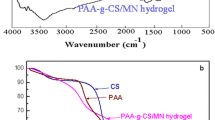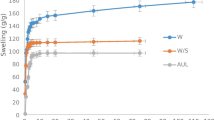Abstract
In this paper, a novel iron oxide nanocomposite hydrogel was prepared by simultaneous formation of superparamagnetic iron oxide nanoparticles and cross-linking of poly(acrylic acid) grafted onto sodium alginate polysaccharide. The prepared optimized hydrogel was characterized by Fourier transform infrared spectroscopy, thermogravimetric analysis, scanning electron microscopy with energy-dispersive X-ray analysis, atomic force microscopy, and transmission electron microscopy. Moreover, swelling capacity of the obtained hydrogel was measured at different temperatures, different pHs, absorption under load, and magnetic field to assess the sensitivity of ION–PAA-g-NaAlg hydrogel. This hydrogel was also examined as a controlled drug delivery system. Doxorubicin and tetracycline (as model drugs) release was investigated at different pHs, different temperatures, and magnetic field. The release curves were nicely fitted by the Korsmeyer–Peppas equation, and the release is controlled by polymer relaxation process.






Similar content being viewed by others
References
Marandi GB, Kermani ZP, Kurdtabar M (2013) Fast and efficient removal of cationic dyes from aqueous solution by collagen-based hydrogel nanocomposites. Polym Plast Technol Eng 52(3):310–318
Guo J, Jin YC, Yang XQ, Yu SJ, Yin SW, Qi JR (2013) Computed microtomography and mechanical property analysis of soy protein porous hydrogel prepared by homogenizing and microbial transglutaminase cross-linking. Food Hydrocoll 31(2):220–226
Paques JP, van der Linden E, van Rijn CJ, Sagis LM (2013) Alginate submicron beads prepared through w/o emulsification and gelation with CaCl2 nanoparticles. Food Hydrocoll 31(2):428–434
Bardajee GR, Hooshyar Z (2014) One-pot synthesis of biocompatible superparamagnetic iron oxide nanoparticles/hydrogel based on salep: characterization and drug delivery. Carbohyd Polym 101:741–751
Debrassi A, Bürger C, Rodrigues CA, Nedelko N, Ślawska-Waniewska A, Dłużewski P, Greneche JM (2011) Synthesis, characterization and in vitro drug release of magnetic N-benzyl-O-carboxymethylchitosan nanoparticles loaded with indomethacin. Acta Biomater 7(8):3078–3085
Yu S, Wu G, Gu X, Wang J, Wang Y, Gao H, Ma J (2013) Magnetic and pH-sensitive nanoparticles for antitumor drug delivery. Colloids Surf, B 103:15–22
Rodríguez-Cabello JC, Prieto S, Reguera J, Arias FJ, Ribeiro A (2007) Biofunctional design of elastin-like polymers for advanced applications in nanobiotechnology. J Biomater Sci Polym Ed 18(3):269–286
Shirsath SR, Patil AP, Patil R, Naik JB, Gogate PR, Sonawane SH (2013) Removal of brilliant green from wastewater using conventional and ultrasonically prepared poly(acrylic acid) hydrogel loaded with kaolin clay: a comparative study. Ultrason Sonochem 20(3):914–923
Matanović MR, Kristl J, Grabnar PA (2014) Thermoresponsive polymers: insights into decisive hydrogel characteristics, mechanisms of gelation, and promising biomedical applications. Int J Pharm 472(1–2):262–275
Matalanis A, McClements DJ (2013) Hydrogel microspheres for encapsulation of lipophilic components: optimization of fabrication & performance. Food Hydrocoll 31(1):15–25
Thévenot J, Oliveira H, Sandre O, Lecommandoux S (2013) Magnetic responsive polymer composite materials. Chem Soc Rev 42(17):7099–7116
Pichayakorn W, Boonme P (2013) Evaluation of cross-linked chitosan microparticles containing metronidazole for periodontitis treatment. Mater Sci Eng, C 33(3):1197–1202
Schumers JM, Fustin CA, Gohy JF (2010) Light-responsive block copolymers. Macromol Rapid Commun 31(18):1588–1607
Gupta KM, Barnes SR, Tangaro RA, Roberts MC, Owen DH, Katz DF, Kiser PF (2007) Temperature and pH sensitive hydrogels: an approach towards smart semen-triggered vaginal microbicidal vehicles. J Pharm Sci 96(3):670–681
Peteu SF (2007) Responsive materials configured for micro-and nanoactuation. J Intell Mater Syst Struct 18(2):147–152
Chen S, Singh J (2005) In vitro release of levonorgestrel from phase sensitive and thermosensitive smart polymer delivery systems. Pharm Dev Technol 10(2):319–325
Lin CC, Metters AT (2006) Hydrogels in controlled release formulations: network design and mathematical modeling. Adv Drug Deliv Rev 58(12–13):1379–1408
Dumitriu S, Chornet E (1997) Immobilization of xylanase in chitosan–xanthan hydrogels. Biotechnol Prog 13(5):539–545
Mahdavinia GR, Rahmani Z, Karami S, Pourjavadi A (2014) Magnetic/pH-sensitive κ-carrageenan/sodium alginate hydrogel nanocomposite beads: preparation, swelling behavior, and drug delivery. J Biomater Sci Polym Ed 25(17):1891–1906
Crini G (2005) Recent developments in polysaccharide-based materials used as adsorbents in wastewater treatment. Prog Polym Sci 30(1):38–70
Homayoni H, Menon JU, Nguyen KT (2014) Chitosan-based nanoparticles for drug delivery. Rev Nanosci Nanotechnol 3(2):133–148
Liang YY, Zhang LM, Jiang W, Li W (2007) Embedding magnetic nanoparticles into polysaccharide-based hydrogels for magnetically assisted bioseparation. ChemPhysChem 8(16):2367–2372
Chung EY, Kim HM, Lee GH, Kwak BK, Jung JS, Kuh HJ, Lee J (2012) Design of deformable chitosan microspheres loaded with superparamagnetic iron oxide nanoparticles for embolotherapy detectable by magnetic resonance imaging. Carbohyd Polym 90(4):1725–1731
Oh JK, Park JM (2011) Iron oxide-based superparamagnetic polymeric nanomaterials: design, preparation, and biomedical application. Prog Polym Sci 36(1):168–189
Mok H, Zhang M (2013) Superparamagnetic iron oxide nanoparticle-based delivery systems for biotherapeutics. Expert Opin Drug Deliv 10(1):73–87
Wu W, Wu Z, Yu T, Jiang C, Kim WS (2015) Recent progress on magnetic iron oxide nanoparticles: synthesis, surface functional strategies and biomedical applications. Sci Technol Adv Mater 16(2):023501
Lee N, Hyeon T (2012) Designed synthesis of uniformly sized iron oxide nanoparticles for efficient magnetic resonance imaging contrast agents. Chem Soc Rev 41(7):2575–2589
Yu X, Tong S, Ge M, Zuo J, Cao C, Song W (2013) One-step synthesis of magnetic composites of cellulose@ iron oxide nanoparticles for arsenic removal. J Mater Chem A 1(3):959–965
Hilger I, Kaiser WA (2012) Iron oxide-based nanostructures for MRI and magnetic hyperthermia. Nanomedicine 7(9):1443–1459
Benderbous S, Corot C, Jacobs P, Bonnemain B (1996) Superparamagnetic agents: physicochemical characteristics and preclinical imaging evaluation. Acad Radiol 3:292–294
Kishimoto M, Minagawa M, Yanagihara H, Oda T, Ohkochi N, Kita E (2012) Synthesis and magnetic properties of platelet γ-Fe2O3 particles for medical applications using hysteresis-loss heating. J Magn Magn Mater 324(7):1285–1289
Pankhurst QA (2006) Nanomagnetic medical sensors and treatment methodologies. BT Technol J 24(3):33–38
Guisasola E, Vallet-Regí M, Baeza A (2018) Magnetically responsive polymers for drug delivery applications. Stimuli Responsive Polym Nanocarriers Drug Deliv Appl 1:143–168
Kurdtabar M, Nezam H, Bardajee GR, Dezfulian M, Salimi H (2018) Biocompatible magnetic hydrogel nanocomposite based on carboxymethylcellulose: synthesis, cell culture property and drug delivery. Polym Sci, Ser B 60(2):231–242
Kurdtabar M, Koutenaee RN, Bardajee GR (2018) Synthesis and characterization of a novel pH-responsive nanocomposite hydrogel based on chitosan for targeted drug release. J Polym Res 25(5):119
Bardajee GR, Hooshyar Z, Rastgo F (2013) Kappa carrageenan-g-poly(acrylic acid)/SPION nanocomposite as a novel stimuli-sensitive drug delivery system. Colloid Polym Sci 291(12):2791–2803
Bardajee GR, Hooshyar Z (2013) A novel biocompatible magnetic iron oxide nanoparticles/hydrogel based on poly(acrylic acid) grafted onto starch for controlled drug release. J Polym Res 20(11):298
Bardajee GR, Mizani F, Hosseini SS (2017) pH sensitive release of doxorubicin anticancer drug from gold nanocomposite hydrogel based on poly(acrylic acid) grafted onto salep biopolymer. J Polym Res 24(3):48
Matalanis A, McClements DJ (2013) Hydrogel microspheres for encapsulation of lipophilic components: optimization of fabrication & performance. Food Hydrocoll 31(1):15–25
Zhou L, He B, Zhang F (2011) Facile one-pot synthesis of iron oxide nanoparticles cross-linked magnetic poly(vinyl alcohol) gel beads for drug delivery. ACS Appl Mater Interfaces 4(1):192–199
Ilg P (2013) Stimuli-responsive hydrogels cross-linked by magnetic nanoparticles. Soft Matter 9(13):3465–3468
Pourjavadi A, Harzandi AM, Hosseinzadeh H (2004) Modified carrageenan 3. Synthesis of a novel polysaccharide-based superabsorbent hydrogel via graft copolymerization of acrylic acid onto kappa-carrageenan in air. Eur Polymer J 40(7):1363–1370
Khan A, El-Toni AM, Alhoshan M (2012) Preparation of thermo-responsive hydrogel-coated magnetic nanoparticles. Mater Lett 89:12–15
Liu TY, Hu SH, Liu KH, Liu DM, Chen SY (2006) Preparation and characterization of smart magnetic hydrogels and its use for drug release. J Magn Magn Mater 304(1):397–399
Philippova O, Barabanova A, Molchanov V, Khokhlov A (2011) Magnetic polymer beads: recent trends and developments in synthetic design and applications. Eur Polym J 47(4):542–559
Liu TY, Hu SH, Liu KH, Liu DM, Chen SY (2006) Preparation and characterization of smart magnetic hydrogels and its use for drug release. J Magn Magn Mater 304(1):397–399
Author information
Authors and Affiliations
Corresponding author
Additional information
Publisher's Note
Springer Nature remains neutral with regard to jurisdictional claims in published maps and institutional affiliations.
Rights and permissions
About this article
Cite this article
Kurdtabar, M., Rezanejade Bardajee, G. Drug release and swelling behavior of magnetic iron oxide nanocomposite hydrogels based on poly(acrylic acid) grafted onto sodium alginate. Polym. Bull. 77, 3001–3015 (2020). https://doi.org/10.1007/s00289-019-02894-w
Received:
Revised:
Accepted:
Published:
Issue Date:
DOI: https://doi.org/10.1007/s00289-019-02894-w




